
|
|||
|---|---|---|---|
|
|
Incidence of the practice of taekwondo in the academic performance of 6-16 year old students Incidencia del taekwondo en el rendimiento académico de estudiantes de 6 a 16 años |
|
|
|
Departamento de Ciencias Humanas y Sociales Universidad de las Fuerzas Armadas ESPE (Ecuador) |
Yaritza Alexandra Cárdenas Vargas Xavier Alejandro Zamora Parra Ph.D. Santiago Calero Morales |
|
|
|
Abstract This paper is aimed at determining the influence of the practice of Taekwondo in the academic performance of students between 6 and 15 years old, in specific and regular subjects of the primary level (Mathematics, Natural Sciences, Social Sciences, Language) and the secondary level (Mathematics, Chemistry, Civics, Literature) by making a comparative analysis between the grades of the first quimester of school year 2015-2016 with a sample of one per three individuals studied (Athletes: 18 and non-athletes: 54). The difference is determined taking into account the academic performance reached in exams using the Mann-Whitney U test. The research concluded that the practice of taekwondo has a positive influence on the academic performance, demostrating that the athletes fulfil the learning results required, and those who do not practice the sport are close to reach that goal in tune with the evaluation scale of the Ministry of Education of Ecuador. In the one hand, it is demonstrated that in the primary level those practicing the sport have positive significant differences in Mathematics (p=0,000) with the best average rank (36,73), while the non-athletes had better indicators in Natural Science (p=0,012), and better average ranks in Social Science (24,15) and Language (23,09). On the other hand, in the secondary level, athletes showed the best indicators in all the subjects studied, being significantly better in Mathematics (p=0,048; Average Rank: 19,79) and Chemistry (p=0,000; Average Rank: 25,00) and higher in average ranks of Civics (19,36) and Language (18,71). Keywords: Taekwondo. Academic performance. Physical activity.
Resumen El objetivo del estudio es determinar cuál es la influencia de la práctica deportiva del Taekwondo en el rendimiento académico de estudiantes entre los 6 y 15 años de edad, en asignaturas comunes y específicas a nivel primario (Matemáticas, Ciencias Naturales, Ciencias Sociales, Lenguaje) y nivel secundario (Matemáticas, Química, Cívica, Literatura), realizando un analisis comparativos entre las notas del primer quimestre del año lectivo 2015-2016, estudiando una muestra con una relación de uno contra tres sujetos estudiados (Deportistas: 18 y No Deportistas: 54). Se determina las diferencias en base al rendimiento docente alcanzado en sus examenes a partir de la Prueba U de Mann-Whitney. La investigación concluyó que la práctica del taewonndo si influye de manera positiva en el rendimiento académico, evidenciando que los deportistas alcanzan los resultados de aprendizaje requeridos, y los no deportistas están próximos a alcanzar los aprendizajes requeridos conforme a la escala de valoración del Ministerio de Educación del Ecuador. Por otra parte, se demuestra a nivel primario que los deportistas presentan diferencias significaticas positivas en la asignatura de Matemática (p=0,000) con el mejor rango promedio (36,73), mientras los no deportistas presentarón mejores indicadores en la asignatura Ciencias Naturales (p=0,012), y mejores rangos promedios en Ciencias Sociales (24,15) y Lenguaje (23,09). Por otra parte, a nivel secundario lo deportistas presentarón los mejores indicadores en todas las asignaturas estudiadas, siendo significativamente mejores en Matemática (p=0,048; Rango Promedio: 19,79) y Química (p=0,000; Rango Promedio: 25,00), y superiores en rangos promedios en la asignatura Cívica (19,36) y Lenguaje (18,71). Palabras clave: Taekwondo. Rendimiento académico. Actividad física.
Reception: 12/19/2015 - Acceptance: 03/20/2016
|
|||
|
|
EFDeportes.com, Revista Digital. Buenos Aires, Año 21, Nº 215, Abril de 2016. http://www.efdeportes.com/ |
|
|
1 / 1
Introduction
The academic performance is the learning acquired by a student as result of several factors in which he develops personality traits, skills, his relationship with the society and the family, the school, the quality of the teaching-educative process, the level of commitment and attention, among others (Morales, 1999; Junco, 2012; Renninger, Hidi & Krapp, 2014; Bercedo, Sánchez, Moreno, Fernández, Martínez & Silva, 2014).
In Ecuador the student evaluation observes, evaluates and records evidence of the teaching process regarding the learning acquisition, based on a continuous and feedback process according to article 184 of the general regulations of the Organic Act of Intercultural Education (Reglamento General de la Ley Orgánica de Educación Intercultural) (LOEI, 2015).
According to article 193 of the general regulations of the LOEI, for a student to pass every level, he must prove an acquisition of the knowledge required through a qualitative and quantitative scale of grades set by the Ministry of Education of Ecuador for both primary and secondary levels, an aspect internationally accepted as a defining criterion of the academic performance (Corea, 2001).
The student’s academic performance is based on several factors (McKenzie & Schweitzer, 2001; Meerbeke / González, 2005; Sansgiry, Bhosle & Sail, 2006; Vargas, 2012), given their relationship with individual personality and social environment. The discipline and determination an athlete needs is totally different from a non-athlete’s, due to the demands of the sport and the management of their time off the academic schedule, that is why it is deduced that the systematic practice of a combat sport might have influence or not in the student’s academic performance, under a specific environment of educative training such as Ecuador.
Those who are not inmersed in sport practice have more time available, hence a more variety of activities, but not necessarily developing positive habits compared to trained individuals (Kovacs, García & Ruiz, 2016), as the formation of values expressed in the environment they live in (Ayala, 2007).
Some related studies as the one carried out by Seder, Villalonga & Domingo (2015, show a negative relationship with sedentary idleness and a positive relationship with study habits, implying differences in the academic performance between athletes and non-athletes.
Due to the responsibility and demand of the sport practice, the athletes should plan the use of their time off academic duties, for that reason their training and competitions cannot be put off. This can make them become more tidy and responsible since they acquire a different perception of their environment (Kovacs, García & Ruiz, 2016), and they can also discard the time dedicated to the academic study by prioritizing training over school duties, an aspect that depends, according to Calero (2014a,b) on the order of institutional, personal and family priorities.
Although it is not determinant that practicing certain high performance sport has positive influence in academic performance, because it brings about aspects related to the environment they are, such as personality, time, aptitudes and skills, the international bibliography consulted has proven, in some cases, a relationship between sport performance and intelliegence (Del Pino, Milán y Ríos, 2015) in athletes with temporary dedication (Capdevila, Bellmunt & Hernando, 2014), added to the influence of the physical activity in general on health, coginition, socialization and academic performance (Ramírez, Vinaccia & Suárez, 2004; Guarin, 2013; Martín, 2014) implying that somehow the sport training provides effective bases, under certain conditions, in some indicators direct and indirectly related to the school performance, some of these conditions studied by Capdevila (2013).
In addition to the abovementioned, it has been found a positive relation between physical activity and academic performance in several studies carried out by the Education Department of California, USA USA (Dwyer T. , 1983; Shephard, 1997; Linder, 1999; Dwyer, 2001; Tremblay, 2000; Linder, 2002; Cocke, 2002) that support the idea that dedicating a substantial time to physical activities in schools might benefit the academic performance of children, and even they suggest there are other types of benefits in comparison with kids that do not pracice sports; some of them already mentioned.
This paper intends to demonstrate that the systematic practice of taekwondo can complement the academic performance by determining if there is positive or negative influence in the school performance, studying the sport training and its relation with the academic performance in exact an social science subjects. On the other hand, it is studied the influence of practicing the sport studied in the academic training of athletes and non-athletes according to the education level (primary and secondary school), demonstrating whether age is a determinant factor in the relation established between the practice of taekwondo and the academic performance reached.
Material and methods
A comparative analysis will be made based on the grades of the first quimester of school year 2015-2016 in a one per three sample (one athlete, three non-athletes; 6-15 years old) by age, with 18 athletes of the Tae Kwon Do Korean Dragon club. In the sample it is evaluated the academic performance on a quantitative scale taken from the Ministry of Education of Ecuador. The athletes chosen must have a constant attendance to sport trainings and at least a national or regional competiton.
The non-athlete group is taken from the Oscar Efrén Reyes School and the Colegio Técnico Humanístico, which must not have an extracurricular sport activity out of their academic schedule.
For this research paper, it is taken as main sample, the quimestral evaluation of the student, which contains the average of mid-term grades of each subject and the quimestral exam. The learning goals differ in each subject. These grades are quantitative and qualitatively expressed in order to prove if the student fulfilled the learning goal according to article 193 of the general regulations of the LOEI, based on the following evaluation scale.

It is studied a sample of 18 athletes, most of them ranging from 6 and 12 years old. The non-athlete sample was of 53 students of the school and institute mentioned. There were selected common and specific subjects of the primary level (Mathematics, Natural Science, Social Science, Language) and of the secondary level (Mathematics, Chemistry, Civics, Literature) in order to obtain a general average, both of athletes and non-athletes by making a comparative analysis to determine if the practice of taekwondo has influence or not in the academic performance of the sample studied. It is applied the Mann-Whitney U test for independent samples establishing the existence of significant differences between the subjects’ grades of athletes and non-athletes, under a siginification level of 0,05.
Results
It was made a segmentation by age both of athletes and non-athletes in order to apply a 3 per 1 relation based on the quimestral average results in each subject, at primary level (Table 1) and secondary level (Table 2).
Table 1. Segmentation by age both of athletes and non-athletes with each subject’s average grades, primary level
|
General Data |
Subjects |
||||||
|
# |
Educative Center |
Age |
A/NA |
Mathematics |
Natural Science |
Social Science |
Language |
|
1 |
Ludoteca |
6 years |
A |
8,00 |
7,50 |
8,00 |
8,50 |
|
1 |
Oscar Efrén Reyes |
6 years |
NA |
7,00 |
7,50 |
7,00 |
7,00 |
|
2 |
Oscar Efrén Reyes |
6 years |
NA |
8,00 |
8,00 |
6,00 |
7,00 |
|
3 |
Oscar Efrén Reyes |
6 years |
NA |
7,50 |
7,80 |
7,30 |
7,40 |
|
2 |
Giordano Bruno |
7 years |
A |
7,00 |
6,00 |
6,30 |
8,00 |
|
3 |
Lev Vygotsky |
7 years |
A |
8,00 |
6,00 |
8,00 |
7,50 |
|
4 |
Oscar Efrén Reyes |
7 years |
NA |
4,00 |
8,00 |
8,20 |
7,30 |
|
5 |
Oscar Efrén Reyes |
7 years |
NA |
6,00 |
5,00 |
5,00 |
6,00 |
|
6 |
Oscar Efrén Reyes |
7 years |
NA |
6,20 |
6,00 |
7,00 |
8,00 |
|
7 |
Oscar Efrén Reyes |
7 years |
NA |
5,70 |
6,10 |
6,00 |
6,00 |
|
8 |
Oscar Efrén Reyes |
7 years |
NA |
5,20 |
8,50 |
7,00 |
7,20 |
|
9 |
Oscar Efrén Reyes |
7 years |
NA |
5,50 |
7,00 |
8,60 |
6,00 |
|
4 |
Policía Nacional |
8 years |
A |
7,00 |
5,80 |
6,80 |
6,80 |
|
10 |
Oscar Efrén Reyes |
8 years |
NA |
5,00 |
6,20 |
8,10 |
7,00 |
|
11 |
Oscar Efrén Reyes |
8 years |
NA |
5,30 |
6,30 |
7,60 |
6,00 |
|
12 |
Oscar Efrén Reyes |
8 years |
NA |
4,90 |
7,00 |
7,40 |
6,40 |
|
5 |
Giordano Bruno |
10 years |
A |
7,00 |
5,50 |
6,80 |
6,50 |
|
6 |
Policía Nacional |
10 years |
A |
7,20 |
6,50 |
7,00 |
6,30 |
|
7 |
Policía Nacional |
10 years |
A |
7,30 |
8,00 |
7,20 |
7,20 |
|
8 |
Policía Nacional |
10 years |
A |
7,00 |
6,00 |
6,50 |
7,20 |
|
13 |
Oscar Efrén Reyes |
10 years |
NA |
5,20 |
9,20 |
8,90 |
9,00 |
|
14 |
Oscar Efrén Reyes |
10 years |
NA |
5,10 |
8,60 |
7,10 |
8,00 |
|
15 |
Oscar Efrén Reyes |
10 years |
NA |
6,90 |
7,50 |
8,00 |
7,00 |
|
16 |
Oscar Efrén Reyes |
10 years |
NA |
6,00 |
7,20 |
7,50 |
7,40 |
|
17 |
Oscar Efrén Reyes |
10 years |
NA |
6,20 |
7,60 |
7,00 |
8,00 |
|
18 |
Oscar Efrén Reyes |
10 years |
NA |
6,10 |
9,00 |
5,60 |
7,50 |
|
19 |
Oscar Efrén Reyes |
10 years |
NA |
6,60 |
6,20 |
7,40 |
6,00 |
|
20 |
Oscar Efrén Reyes |
10 years |
NA |
6,20 |
6,80 |
8,10 |
7,50 |
|
21 |
Oscar Efrén Reyes |
10 years |
NA |
6,40 |
7,10 |
8,20 |
7,90 |
|
22 |
Oscar Efrén Reyes |
10 years |
NA |
5,00 |
6,30 |
8,40 |
7,50 |
|
23 |
Oscar Efrén Reyes |
10 years |
NA |
6,50 |
5,00 |
7,70 |
6,20 |
|
24 |
Oscar Efrén Reyes |
10 years |
NA |
6,60 |
7,00 |
7,80 |
6,50 |
|
9 |
Oscar Efrén Reyes |
11 years |
A |
8,50 |
6,00 |
6,50 |
6,30 |
|
10 |
Kyrios |
11 years |
A |
7,00 |
5,90 |
5,50 |
6,30 |
|
11 |
Emaus Fe y Alegría |
11 years |
A |
7,10 |
7,00 |
7,20 |
7,00 |
|
25 |
Oscar Efrén Reyes |
11 years |
NA |
6,50 |
8,00 |
7,90 |
7,80 |
|
26 |
Oscar Efrén Reyes |
11 years |
NA |
6,20 |
7,10 |
8,00 |
7,10 |
|
27 |
Oscar Efrén Reyes |
11 years |
NA |
6,30 |
7,40 |
4,00 |
7,20 |
|
28 |
Oscar Efrén Reyes |
11 years |
NA |
6,50 |
8,30 |
7,50 |
8,00 |
|
29 |
Oscar Efrén Reyes |
11 years |
NA |
6,60 |
7,60 |
6,00 |
7,40 |
|
30 |
Oscar Efrén Reyes |
11 years |
NA |
6,00 |
5,50 |
6,80 |
7,60 |
|
31 |
Oscar Efrén Reyes |
11 years |
NA |
5,00 |
6,30 |
6,70 |
7,60 |
|
32 |
Oscar Efrén Reyes |
11 years |
NA |
5,00 |
9,50 |
6,50 |
7,50 |
|
33 |
Oscar Efrén Reyes |
11 years |
NA |
7,10 |
7,40 |
7,80 |
6,30 |
Legend: A/NA: A= Athlete; NA= Non-athlete
Table 2. Segmentation by age both of athletes and non-athletes with each subject’s average grades, secondary level.
|
General Data |
Subjects |
||||||
|
# |
Educative Center |
Age |
A/NA |
Mathematics |
Chemistry |
Civics |
Literature |
|
12 |
Paulo Sexto |
12 years |
A |
7,60 |
6,50 |
6,80 |
7,90 |
|
13 |
Emaus Fe y Alegría |
12 years |
A |
7,60 |
7,90 |
7,50 |
8,60 |
|
14 |
Sto. Domingo de Guzmán |
12 years |
A |
7,00 |
8,20 |
7,60 |
6,10 |
|
15 |
Paulo Sexto |
12 years |
A |
8,00 |
7,60 |
7,80 |
6,30 |
|
16 |
Paulo Sexto |
12 years |
A |
9,00 |
8,80 |
7,50 |
6,40 |
|
1 |
Colegio T.H. Quito |
12 years |
NA |
4,50 |
4,00 |
8,00 |
7,00 |
|
2 |
Colegio T.H. Quito |
12 years |
NA |
6,20 |
4,00 |
5,00 |
6,00 |
|
3 |
Colegio T.H. Quito |
12 years |
NA |
7,60 |
4,50 |
7,60 |
4,90 |
|
4 |
Colegio T.H. Quito |
12 years |
NA |
5,00 |
5,00 |
6,00 |
7,50 |
|
5 |
Colegio T.H. Quito |
12 years |
NA |
4,00 |
5,20 |
4,50 |
5,60 |
|
6 |
Colegio T.H. Quito |
12 years |
NA |
6,20 |
5,30 |
6,00 |
6,00 |
|
7 |
Colegio T.H. Quito |
12 years |
NA |
6,30 |
5,40 |
5,50 |
6,00 |
|
8 |
Colegio T.H. Quito |
12 years |
NA |
8,50 |
5,40 |
5,00 |
6,00 |
|
9 |
Colegio T.H. Quito |
12 years |
NA |
7,60 |
5,40 |
4,80 |
7,90 |
|
10 |
Colegio T.H. Quito |
12 years |
NA |
4,50 |
5,50 |
6,00 |
6,50 |
|
11 |
Colegio T.H. Quito |
12 years |
NA |
8,00 |
5,60 |
8,00 |
7,00 |
|
12 |
Colegio T.H. Quito |
12 years |
NA |
4,30 |
5,60 |
5,00 |
6,20 |
|
13 |
Colegio T.H. Quito |
12 years |
NA |
7,00 |
5,60 |
4,00 |
6,30 |
|
14 |
Colegio T.H. Quito |
12 years |
NA |
6,00 |
5,60 |
7,50 |
7,80 |
|
15 |
Colegio T.H. Quito |
12 years |
NA |
7,00 |
6,00 |
6,30 |
9,00 |
|
17 |
Fernández Madrid |
13 years |
A |
5,00 |
8,00 |
6,40 |
8,00 |
|
16 |
Colegio T.H. Quito |
13 years |
NA |
4,50 |
6,00 |
7,00 |
6,00 |
|
17 |
Colegio T.H. Quito |
13 years |
NA |
8,60 |
6,00 |
7,50 |
6,20 |
|
18 |
Colegio T.H. Quito |
13 years |
NA |
7,00 |
6,00 |
4,20 |
5,20 |
|
18 |
Fernández Madrid |
15 years |
A |
7,50 |
7,00 |
7,50 |
8,00 |
|
19 |
Colegio T.H. Quito |
15 years |
NA |
6,00 |
6,10 |
7,00 |
8,00 |
|
20 |
Colegio T.H. Quito |
15 years |
NA |
6,00 |
6,20 |
7,40 |
7,70 |
|
21 |
Colegio T.H. Quito |
15 years |
NA |
4,50 |
6,20 |
8,00 |
9,00 |
Legend: A/NA: A= Athlete; NA= Non-athlete
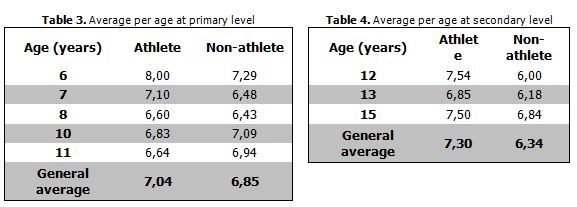
The average at the primary level (table 3) has a small and positive difference of the athletes sample (7,04) compared to that of the non-athletes’ (6,85), which is not a significant difference according to the Mann-Whitney U Test (p=0,690). On the other hand, the average grades obtained in athletes and non-athletes of the secondary level favored the former with 7,30 compared to 6,34 of the non-athletes, whose difference is not significant according to the Mann-Whitney U Test (p=0,100).
Table 5. Evaluation scale of the learning results in tune with
what is established by the Ministry of Education of Ecuador

The average of the primary level athletes is 7,04 (it fulfils the required learning) in relation with the evaluation scale of the ministry of education (table 5), while the group of non-athletes at this level has an average of 6.85 (is about to fulfill the required learning).
Table 6. Mann-Whitney U test to relate the academic average
of Mathematics in athletes and non-athletes of primary level
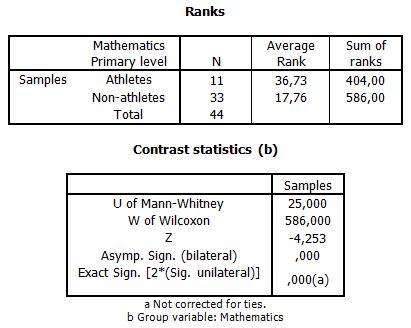
The Mann-Whitney U test determined a significant difference between the grades obtained in the subject of Mathematics of primary level athletes and non-athletes (p=0,000), in which the average rank of athletes is higher than that of non-athletes (36,73 y 17,76 respectively).
Table 7. Mann-Whitney U test to relate the academic average
of Natural Science in athletes and non-athletes of primary level
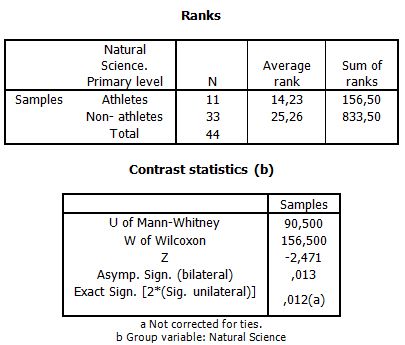
The Mann-Whitney U test determined a significant difference between the grades obtained in the subject of Natural Science of primary level athletes and non-athletes (p=0,012). The higher average rank was established in non-athletes (25,26) compared to the athletes (14,23).
Table 8. Mann-Whitney U test to relate the academic average
of Social Science in athletes and non-athletes of primary level
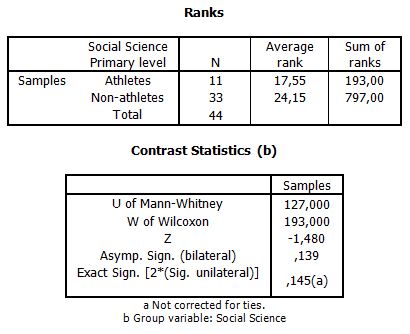
The Mann-Whitney U test determined the non-existence of significant differences between te grades obtained in the subject of Social Science in primary level athletes and non-athletes (p=0,1145). The higher average rank was established in non-athletes (24,15) compared to athletes (17,55).
Table 9. Mann-Whitney U test to relate the academic average
of Language in athletes and non-athletes of primary level
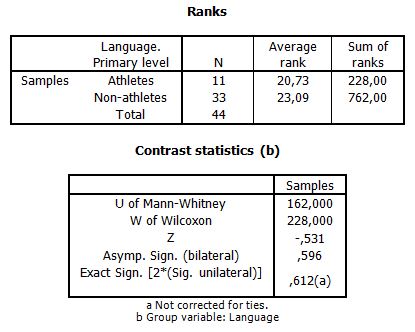
The Mann-Whitney U test determined the non-existence of significant differences between the grades obtained in the subject of Language in primary level athletes and non-athletes (p=0,612). The higher average rank was establishd in the non-athletes (23,09) compared to the athletes (20,73).
Table 10. Mann-Whitney U test to relate the academic average
of Mathematics in athletes and non-athletes of secondary level
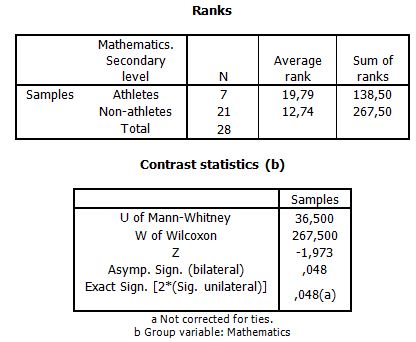
The Mann-Whitney U test determined the existence of significant differences between the grades obtained in the subject of Mathematics of secondary level athletes and non-athletes (p=0,048). The higher average rank was established in athletes (19,79) compared to non-athletes (12,74).
Table 11. Mann-Whitney U test to relate the academic average
of Chemistry in athletes and non-athletes of secondary level
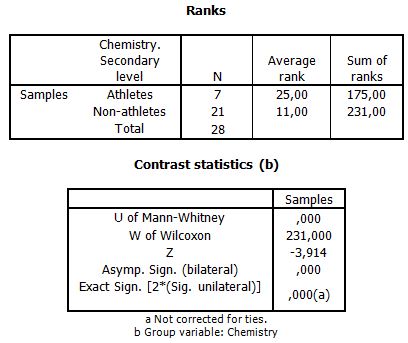
The Mann-Whitney U test determined the existence of significant differences between the grades obtained in the subject of Chemistry of secondary level athletes and non-athletes (p=0,000). The higher average rank was established in athletes (25,00) compared to non-athletes (11,00).
Table 12. Mann-Whitney U test to relate the academic average
of Civics in athletes and non-athletes of secondary level
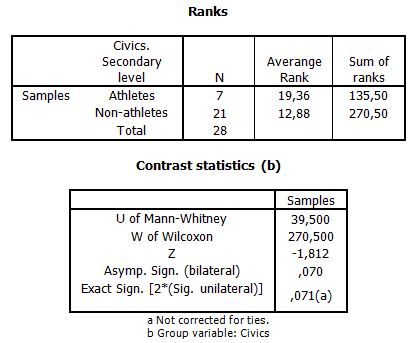
The Mann-Whitey U test determined the non-existence of significant differences between the grades obtained in the subject of Civics of secondary level athletes and non-athletes (p=0,071). The higher average rank was established in athletes (19,36) compare to non-athletes (12,88).
Table 13. Mann-Whitney U test to relate the academic average
of Literature in athletes and non-athletes of secondary level

The Mann-Whitey U test determined the non-existence of significant differences between the grades obtained in the subject of Literature of secondary level athletes and non-athletes (p=0,126). The higher average rank was established in athletes (18,71) compared to non-athletes (13,10).
Discussion and conclusions
In terms of arithmetic mean the athletes presented a higher academic performance as average in the primary level (7,04), with a slight increase in the secondary level (7,30) compared to non-athletes (Primary level: 6,85; secondary level: 6,34), for what we can infer that in general the students practicing taekwondo have better grades than their non-practicing classmates.
The significant differences depend on the subject studied. Therefore, athletes of the pimary level presented positive significant differences only in Mathematics (p=0,000; Average rank: 36,73), meanhwhile non-athletes had better results in natural Science (p=0,012; Average rank: 25,26). On the other hand, there were no significant differences between primary level athletes and non-athletes in Social Science (p=0,145) and Language (p=0,612), although the average ranks have favored non-athletes in Social Science and Language (24,15; 23,09, respectively).
In the secondary level, athletes continue to have positive significant differences in Mathematics (p=0,048) with an average rank higher than non-athletes (19,79). On the other hand, another exact science subject (Chemistry) also presented positive significant differences in favor of athletes (p=0,000) with a favorable average rank of 25,00. In the subject of Civics, in which one of the basic goals is the formation of values in Ecuador (Ayala, 2007), under a significance level of 0,05, the comparison between the grades of athletes and non-athletes was not significant according to the Mann-Whitney U test, since the average rank of athletes was higher than that of non-athletes (19,36 y 12,88, respectively), so we can infer that athletes have a slightly better performance in that subject, the sames as in Literature (Athletes: 18,71; Non-athletes: 13,10), although the latter did not present significant differences (p=0,126).
The analysis of the data can be related to papers similar to the one develped by Junco (2012), in which the author states that the level of commitment of the student is directly related to the academic performance, an aspect that acoording to the results does not apply to all educative levels neither has influence in the academic performance of athletes in all the subjects.
If it is true that an athlete presents higher and relative indicators such as organization and attention than non-athletes (Bercedo, Sánchez, Moreno, Fernández, Martínez & Silva, 2014), this factor might have influence in the exact science subjects in the two educative levels analyzed (Mathematics and Chemistry), in which the athletes obtained better qualifications than non-athletes.
However, the indicators of attention and commitment pointed out by Bercedo Sánchez, Moreno, Fernández, Martínez & Silva (2014) and Junco (2012), as well as the responsibility, emotional stability and extroversion, among others noted by Kovacs, García & Ruiz (2016), have not been enough for athletes to reach better results in some social science subjects of the primary level (Natural Science, Social Science and Language), although it could be a favorable factor in older students (secondary level), since in all subjects studied the athletes presented better average ranks than non-athletes (Mathematics, Chemistry, Civis and Literature), being sgnificantly different from the first two subjects described at secondary level according to the Mann-Whitney U test.
We agree with Seder, Villalonga & Domingo (2015) that the positive results scientifically demonstrated by the practice of physical activity could be used by the sport professionals to explain to parents the additional benefits of the practice of sports, avoiding the drop outs by traditionally non-justified reasons in all cases such as unfavorable academic performance.
In the research report made by Capdevilla (2013), it is determined that the practice of a sport does have influence in the academic performance due to social, environmental, cultural, geographic and family factors, without specifying the indicators fulfilled by athletes in diverse subjects. The mentioned author justifies her statements based on the fact that the athletes studied have a better use of their time, becoming more responsible in their academic duties.
We stand for the practice of a sport since it brings several benefits that indirectly have influence in the school performance related to the social, cultural and family level, since the personality of an athlete takes part in the relationship with their environment, for which we accept the statements of authors that have focused their papers on this regard, such as Ramírez, Vinaccia & Suárez (2004), Guarin (2013) and Martín (2014), both in the theoretical and practical point of view.
Since the academic performance is related to multiple factors (Morales, 1999; Junco, 2012; Renninger, Hidi & Krapp, 2014; Bercedo, Sánchez, Moreno, Fernández, Martínez & Silva, 2014), already noted, it has been demonstrated that the practice of a specific combat sport (taekwondo) might directly or indirectly have influence in the academic perfomance of primary level students, with improvements in the secondary level, as it was demonstrated with the general averages obtained.
That implies that, the older the student the more necessary it is to systematically practice a sport, and in the case of taekwondo, under the educative training conditions of Ecuador, it favors the learning of contents in the subjects studied. One of the causes that might justify this phenomenon relates with sedentary idleness that could affect non-athletes, as it is affirmed by Seder, Villalonga & Domingo (2015).
Bibliography
-
Ayala, E. (2007). Programa de Cívica. Educación para la democracia. (U. S. Bolivar, Ed.) Recuperado el 2016 de Enero de 03, de http://www.uasb.edu.ec/UserFiles/379/File/7%20civica.pdf
-
Bercedo, Sánchez, J., Moreno, A. J., Fernández, T., Martínez, J. A. & Silva, J. (2014). Evaluación de la atención en deportistas de artes marciales. Revista de Psicología del deporte, 23(1), 0087-94.
-
Calero, S. (2014a). Fundamentos del entrenamiento deportivo optimizado. En D. y. Curso impartido en la Facultad de Educación Física (Ed.). Guayaquil: EduQuil.
-
Calero, S. (2014b). Fundamentos del entrenamiento optimizado. Cómo lograr un alto rendimiento deportivo en el menor tiempo posible. En P. C. México (Ed.). Villahermosa, Tabasco.
-
Capdevila, A. (2013). El rendimiento académico de adolescentes de 2º ciclo de ESO: Diferencias entre deportistas y no-deportistas. Departamento de Educación. Facultad de Ciencias Humanas y Sociales. Castellón: Universitat Jaume I De Castellón.
-
Capdevila, A., Bellmunt, H. & Hernando, C. (2014). Estudio del rendimiento académico en atletas adolescentes del Club de Atletismo Playas de Castellón. Revista de Ciencias del Deporte, 10(1).
-
Cocke. (2002). Brain May Also Pump up from Workout. Canada: Society for Neuroscience.
-
Corea, N. C. (2001). Régimen de vida de los escolares y rendimiento académico. Tesis doctoral. (U. A. Barcelona, Ed.) Recuperado el 29 de Enero de 2016, de http://www.tdx.cat/handle/10803/5002
-
Dwyer, T. (1983). An investigation of the effects of daily physical activity on the health of primary school students in South Australia. En International Journal of epidemiologists, 12 (pp. 308-313).
-
Dwyer, T. e. (2001). Relation of Academic Performance to Physical Activity and Fitness in Children. En Pediatric Exercise Science 13 (pp. 225-238).
-
García, A., Ruiz, R. & Pujals, C. (2011). Diferencias en personalidad en función de la práctica o no deportiva, nivel de competición y categoría por edad en jugadores de fútbol desde el modelo de Costa y McCrae. Revista de Psicología del deporte, 20(1), 29-44.
-
Gómez Castañeda, P. (2002). Alcances obtenidos mediante la planificacion y control del proceso de entrenamiento deportivo en el taekwondo. EFDeportes.com, Revista Digital. Buenos Aires, Nº 151. http://www.efdeportes.com/efd51/tkwd.htm
-
Guarin, L. (2013). El impacto de la actividad física y el deporte sobre el rendimiento académico: Una revisión teórica. Revista Edu-Física, 5(12).
-
Junco, R. (2012). Too much face and not enough books: The relationship between multiple indices of Facebook use and academic performance. Computers in Human Behavior, 28(1), 187-198.
-
Kovacs, García, A. & Ruiz, R. (2016). DIferencias en personalidad en función de la práctica o no deportiva y categoría por edad en jugadores de fútbol de rendimiento desde el modelo de Costa y McCrae. Revista Iberoamericana de Psicología del Ejercicio y el Deporte, 11(1), 23-29.
-
Linder, K. (1999). Sport Participation and Perceived Academic Performance of School Children and Youth. En Pediatric Exercise Science, 11, pp. 129-144.
-
Linder, K. (2002). The Physical Activity Participation - Academic Performance Relationship Revisited: Perceived and Actual Performance and the Effect of Banding (Academic Tracking). En Pediatric Exercise Science, 14 (pp. 155-170).
-
LOEI (2015). Educación de Calidad. Recuperado el 08 de Marzo de 2016, de Reglamento general a la ley orgánica de educación intercultural. 25 de Noviembre. Decreto Nº 1241: http://educaciondecalidad.ec/ley-educacion-intercultural-menu/reglamento-loei-texto.html
-
Martín, A. (2014). Rendimiento académico y actividad física en adolescentes: un estudio en 2º ciclo de la ESO del IES Pando de Oviedo. Universidad de Oviedo, Facultad de Formación del Profesorado y Educación, Oviedo.
-
Morales, A. (1999). Proyecto de investigación educativa: Entorno familiar y rendimiento escolar. (C. d. Andalucía, Ed.) Recuperado el 29 de Enero de 2016, de http://redined.mecd.gob.es/xmlui/bitstream/handle/11162/2887/00120080000309.pdf?sequence=1
-
Ramírez, W., Vinaccia, S. & Suárez, G. R. (2004). El impacto de la actividad física y el deporte sobre la salud, la cognición, la socialización y el rendimiento académico: una revisión teórica. Revista de Estudios sociales, 18, 67-75.
-
Renninger, A., Hidi, S. & Krapp, A. (2014). The role of interest in learning and development. USA: Psychology Press.
-
Seder, A. C., Villalonga, H. B. & Domingo, C. (2015). Estilo de vida y rendimiento académico en adolescentes: comparación entre deportistas y no-deportistas. RETOS. Nuevas Tendencias en Educación Física, Deporte y Recreación, 27), 28-33.
-
Shephard, R. (1997). Relation of Academic Performance to Physical Activity and Fitness in Children. En Pediatric Exercise Science, 13 (pp. 225-238).
-
Tremblay, M. (2000). The Relationship Between Physical Activity, Self-Esteem, and Academic Achievement in 12-Year-Old Children. En Pediatric Exercise Science, 12 (pp. 312-324).
Another articles in English

|
|
|---|---|
|
EFDeportes.com, Revista
Digital · Año 21 · N° 215 | Buenos Aires,
Abril de 2016 |
|